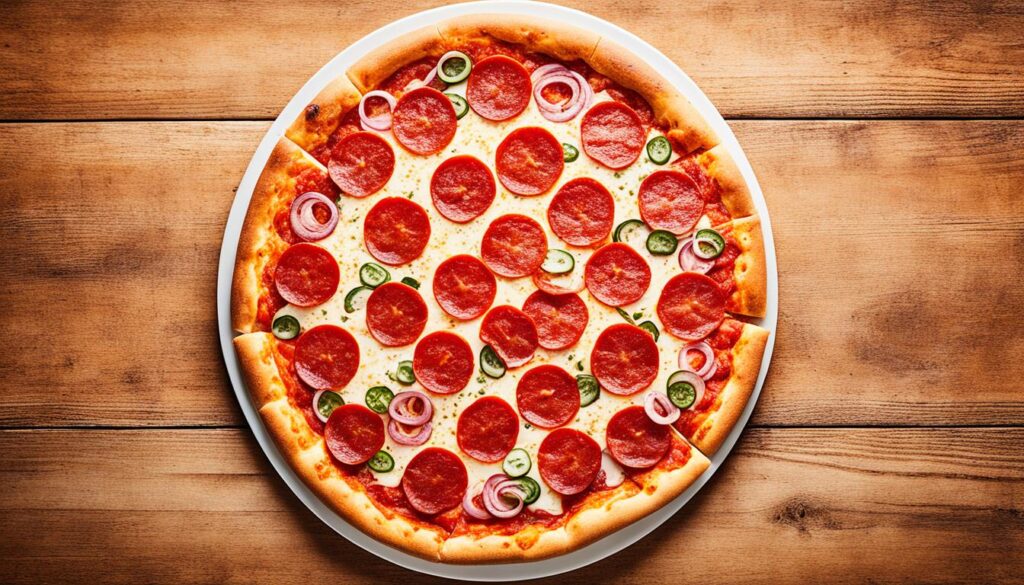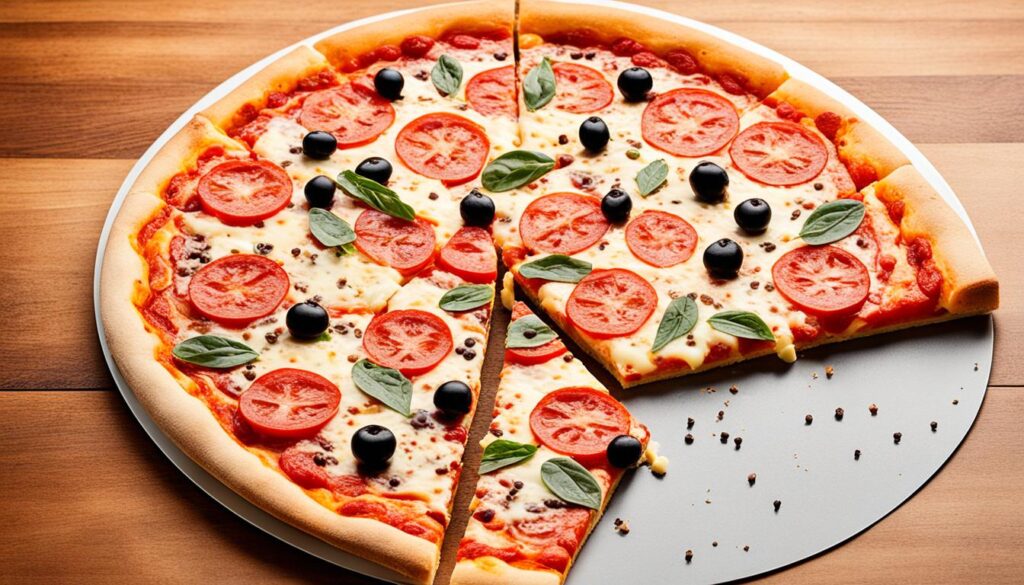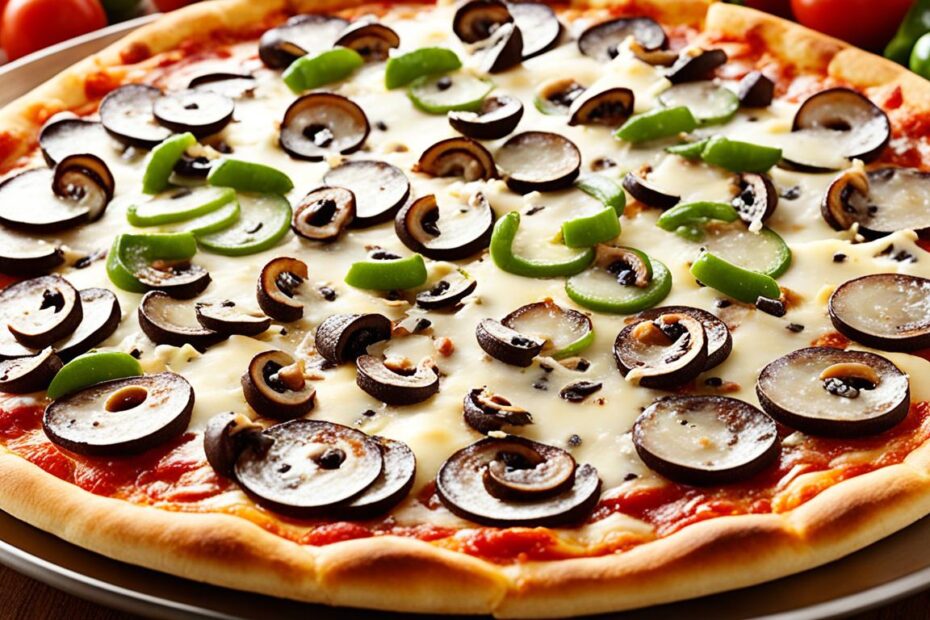It’s Friday night and you’re with friends at your favorite pizza spot. The smell of fresh pizza fills the air. You’re excited but wondering, “How many calories are in a slice of pizza?”
For many, pizza is a favorite for gatherings or easy nights in. But, understanding its nutritional value can be tricky. Are you adding lots of calories with each bite? Or, can you eat pizza with no worries?
We’re here to clear up the calories in pizza slices. Let’s talk about the calories in various types of pizza. We’ll also look at what affects its nutrition and share tips for healthier pizza eating.
How Many Calories in a Slice of Cheese Pizza?
A slice of cheese pizza has about 250-350 calories. The calorie count changes with the slice’s size and toppings. For instance, a medium, hand-tossed slice might be 200 calories. Meanwhile, a thin crust slice could have 290 calories. Carbs, fats, proteins, and cholesterol are also in cheese pizza. So, think about these when looking at a slice’s nutrition.
Knowing the calories in a cheese pizza slice is crucial. It usually falls between 250-350 calories. But, this can differ depending on the slice’s size and how thick the crust is. A hand-tossed slice could be less in calories compared to a thin crust one. Always keep in mind the pizza’s carb, fat, protein, and cholesterol content. This helps you choose wisely when enjoying a slice.
Calories in Different Types of Pizza
Not all pizzas are equal when it comes to calories. The calorie count varies with the type of pizza. Let’s explore the calorie differences in various pizza styles:
Neapolitan Pizza
Neapolitan pizza is simple and tasty with tomatoes and mozzarella. It has about 230 calories per slice. The thin crust of this pizza keeps it light on calories, making it a great option.
New York-Style Pizza
New York-style pizza offers a thinner crust that’s easy to fold. A typical slice of this pizza has around 250 calories. Its thin crust gives a nice crunch without packing on too many calories.
Pepperoni Pizza
Pepperoni pizza is a big hit and a bit heavier on calories. A slice has roughly 275 calories. The blend of cheese, pepperoni, and thicker crust increases its calorie content.
Chicago-Style Deep Dish Pizza
For a more filling choice, there’s Chicago-style deep dish pizza. It features a thick crust and plenty of toppings. Each slice has around 280 calories, making it a more satisfying option for hunger.
Detroit-Style Pizza
Detroit-style pizza is square with a thick crust and crispy edges. A slice from this type of pizza is about 290 calories. Its thickness contributes to a slightly higher calorie count than other pizzas.
Choosing the right pizza involves looking at toppings and style. Whether you love Neapolitan, New York-style, pepperoni-filled slices, or the deeper dish options, knowing the calorie count is key. It helps make choices that fit your dietary goals.

Factors Affecting Pizza’s Calorie Content
Pizza’s calorie count changes based on a few things. Toppings like pepperoni, sausage, or extra cheese can make it higher in calories. The crust type also makes a difference. For example, thin-crust pizzas usually have less calories than thick crusts. When you add in various pizza brands, the calorie count per slice can differ a lot. So, think about the toppings, crust, and brand when counting calories.
There’s more to pizza than just cheese and toppings. The thickness of the crust and the brand you choose impact calories too. If you add pepperoni, sausage, or extra cheese, your pizza will have more calories. So, choose wisely when customizing your order.
Choosing thin-crust over thick-crust can help cut down on calories. Thin-crust pizzas use less dough, which means fewer carbs and calories. If you’re trying to eat less, a thin-crust pizza may be the better option.
Each pizza brand has its own calorie count. Big names like Domino’s and Pizza Hut have unique pizza sizes and recipes. It’s smart to look at the nutrition info from the place you’re buying your pizza from. This helps you know the exact calorie content of your slice.
Pizza’s Nutritional Value
Many might not know that pizza can be nutritious. Its nutritional value depends on what’s in it. But, it does have some key components worth mentioning.
Pizza’s crust is made of carbohydrates. These give you energy. So, any pizza, thin or thick, gets some of its nutrition from the crust.
The cheese and toppings are next. Pizza cheese has protein, good for your body’s tissues. Toppings, like veggies or meats, also add protein. Protein helps you feel full.
Cheese, besides protein, has fats. These are needed in your diet. Fats give energy, help absorb vitamins, and make pizza taste great.

Quote:
“Pizza can be a good source of calcium, especially if it contains a generous amount of cheese. Calcium is important for building and maintaining strong bones and teeth.”
Cheese is rich in calcium too. This mineral is vital for bones and teeth. Besides, pizza may carry other vitamins and minerals, based on its ingredients.
Pizza’s nutritional worth can change a lot. This depends on what goes on it and how it’s made. A veggie-heavy pizza is healthier than one loaded with meat and cheese. Plus, the pizza’s size affects its calories and nutrition.
Choosing healthier toppings, like more vegetables, can make your pizza better. This boosts vitamins and minerals and adds fiber. Going for whole wheat crusts over white ones means more fiber too.
But don’t forget, moderation is key with pizza. Pairing it with other nutritious foods and staying active is important. This way, you can enjoy pizza and still be healthy.
Making Healthier Choices When Eating Pizza
Eating pizza can fit into a good diet if you choose wisely. Go for thin-crust pizzas or ones topped with vegetables. This helps cut calories and boost nutrition. Pizzas with whole wheat crusts are also a great pick. They give you more fiber.
Enjoy your pizza but watch the size. It’s good not to eat too much. Eat other nutritious foods and keep moving to stay fit. This way, you aim for the best health.
To be smart about pizza, pick thin crust. Add vegetables for nutrition and choose whole wheat crusts for the extra fiber. Watch how much you eat. Add other healthy foods to your meals. Being informed helps you stay healthy.
Quote:
“Choosing healthier options when eating pizza doesn’t mean you have to sacrifice flavor. Adding a variety of colorful vegetables and opting for a thin-crust pizza can make for a delicious and nutritious meal.” – Dr. Emily Johnson, Registered Dietitian
Remember these tips when eating pizza. They let you enjoy it and still get key nutrients. For more ideas, check our guide on how to make healthier choices with your pizza. Keep your portions in mind. Mix in healthy ingredients. Enjoy every slice!
Conclusion
The calorie count in one slice of pizza varies. It depends on the toppings, crust, and the brand. A slice of cheese pizza has about 250-350 calories on average.
The calories will be different for Neapolitan, New York-style, pepperoni, or other types. It’s key to watch how much you eat. Choosing healthier options helps you balance your diet.
By being smart about your pizza choices, and not overeating, you can stay healthy. Enjoy your pizza without blowing your nutritional goals.
